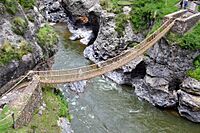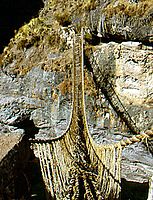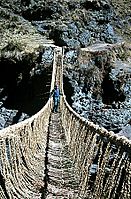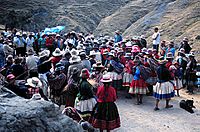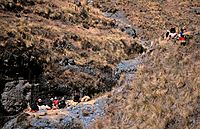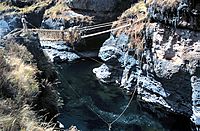Queshuachaca facts for kids
Quick facts for kids QueshuachacaQ’ichwa Chaka |
|
|---|---|
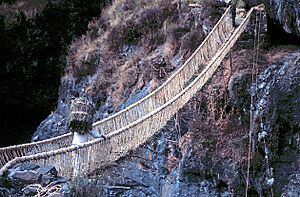
Queshuachaca bridge
|
|
| Carries | Pedestrians |
| Crosses | Apurímac River |
| Locale | Quehue District, Peru |
| Characteristics | |
| Design | Inca rope bridge |
| Material | Ichu grass |
| Total length | 28 metres (92 ft) |
| Width | 1.2 metres (3 ft 11 in) |
| Knowledge, skills and rituals related to the annual renewal of the Q'eswachaka bridge | |
|---|---|
|
UNESCO Intangible Cultural Heritage
|
|
| Country | Peru |
| Reference | 00 |
| Region | Latin America and the Caribbean |
| Inscription history | |
| Inscription | 2013 (8th session) |
| List | Representative |
The Queshuachaca bridge is a special and ancient bridge in Peru. Its name comes from the Cuzco Quechua language, meaning 'straw-rope bridge'. This bridge is the very last Inca rope bridge still in use today. It is made entirely of strong grass ropes. The bridge stretches across the Apurímac River near a place called Huinchiri, in the Quehue District.
Even though there is a modern bridge nearby, local people keep an old tradition alive. They rebuild the Queshuachaca bridge every year. This happens during the second week of June. Different families from communities like Chaupibanda, Choccayhua, Huinchiri, and Collana Quehue work together. They prepare many grass ropes to make new cables for the bridge. Others get mats ready for the bridge's floor. Rebuilding the bridge is a big team effort. In ancient times, this work was like a tax. Today, the builders say they do it to honor their ancestors and the Pachamama, or Earth Mother.
The bridge and its yearly renewal have become quite famous. They have been shown in TV shows like Nova and on the BBC. There is also a documentary film about it called The Last Bridge Master. The bridge is now a small tourist attraction. Visitors can pay a small fee to use the road during the festival. They can also walk across the newly built bridge. In 2009, the government of Peru recognized the bridge and its maintenance as an important part of Peru's culture. Now, some outside groups help support the tradition. The main engineer for the bridge was Victoriano Arizapana.
What Happened to the Bridge?
The Queshuachaca bridge has faced some challenges. In 2020 and early 2021, there was less maintenance because of the COVID-19 pandemic. Because of this, the bridge broke in March 2021. But the local communities quickly rebuilt it in the weeks that followed.
Sadly, the bridge broke again early on May 17, 2025. This happened because some unknown people damaged it on purpose. The local prosecutor's office started an investigation into this act. The good news is that the bridge was restored once more after this incident.
How the Bridge is Renewed
The process of renewing the Queshuachaca bridge is a fascinating tradition. It shows how people work together and use ancient skills. The communities gather special grass called ichu. They twist this grass into strong ropes. These ropes are then braided together to form thick cables. These cables become the main structure of the bridge.
The old bridge is carefully taken apart. Then, the new, strong grass cables are stretched across the river. Smaller ropes are used to tie the main cables together. Mats made from grass are laid down to create the walking surface. This entire process takes several days. It is a true community effort, passed down through generations.
See also
 In Spanish: Puente Queshuachaca para niños
In Spanish: Puente Queshuachaca para niños


